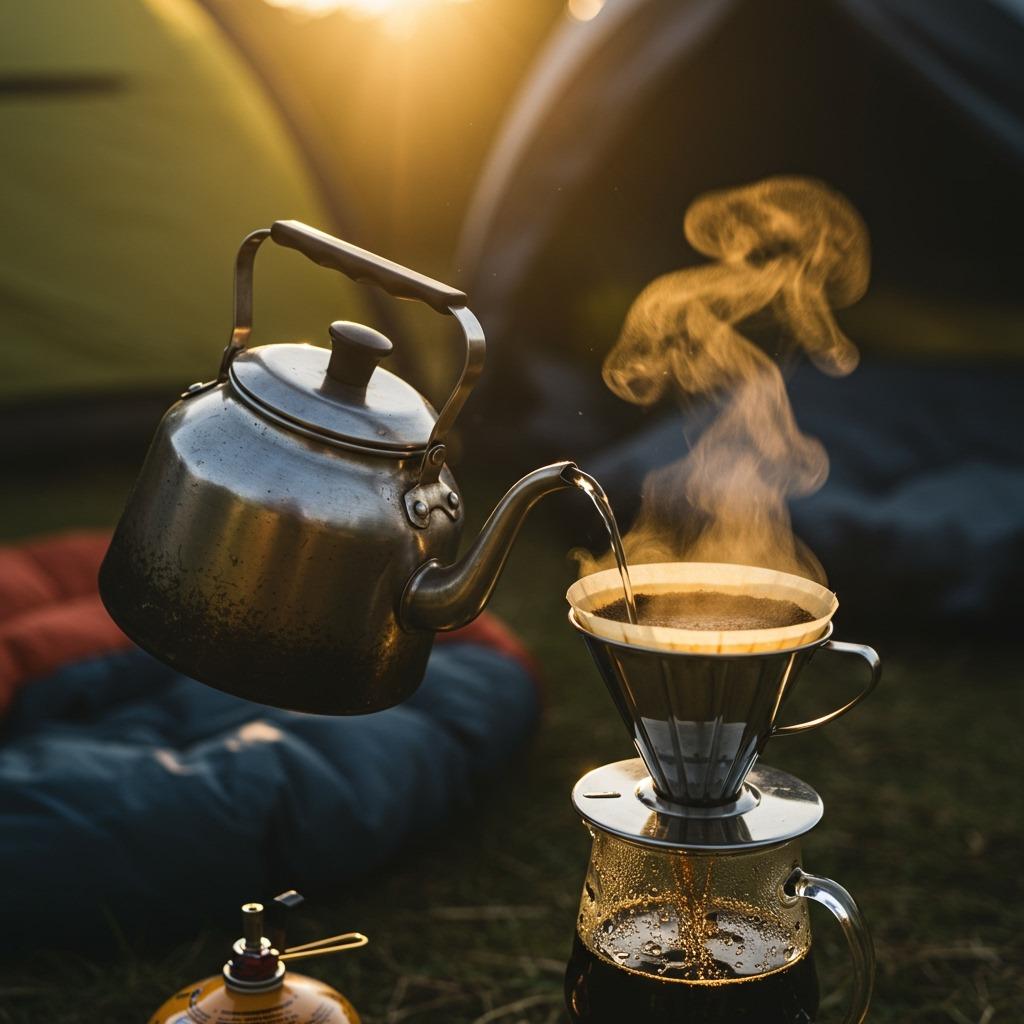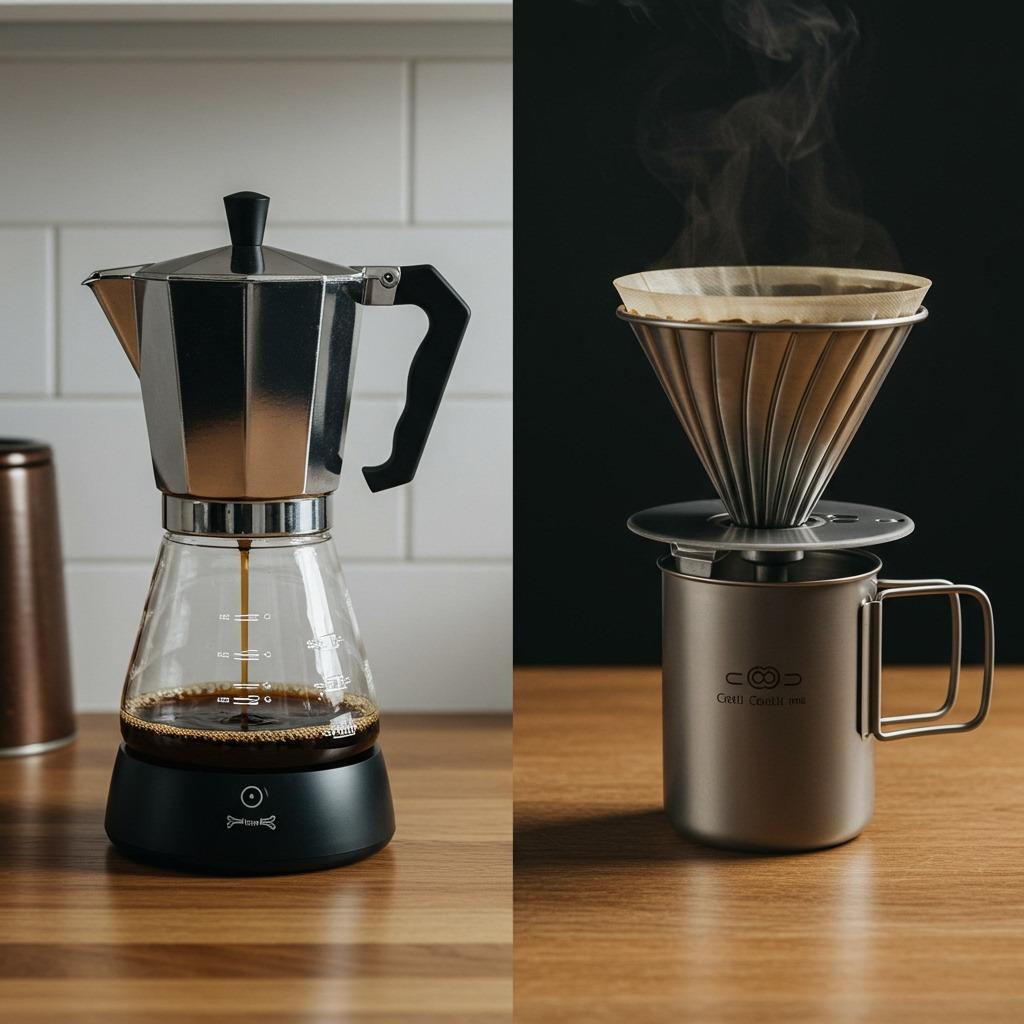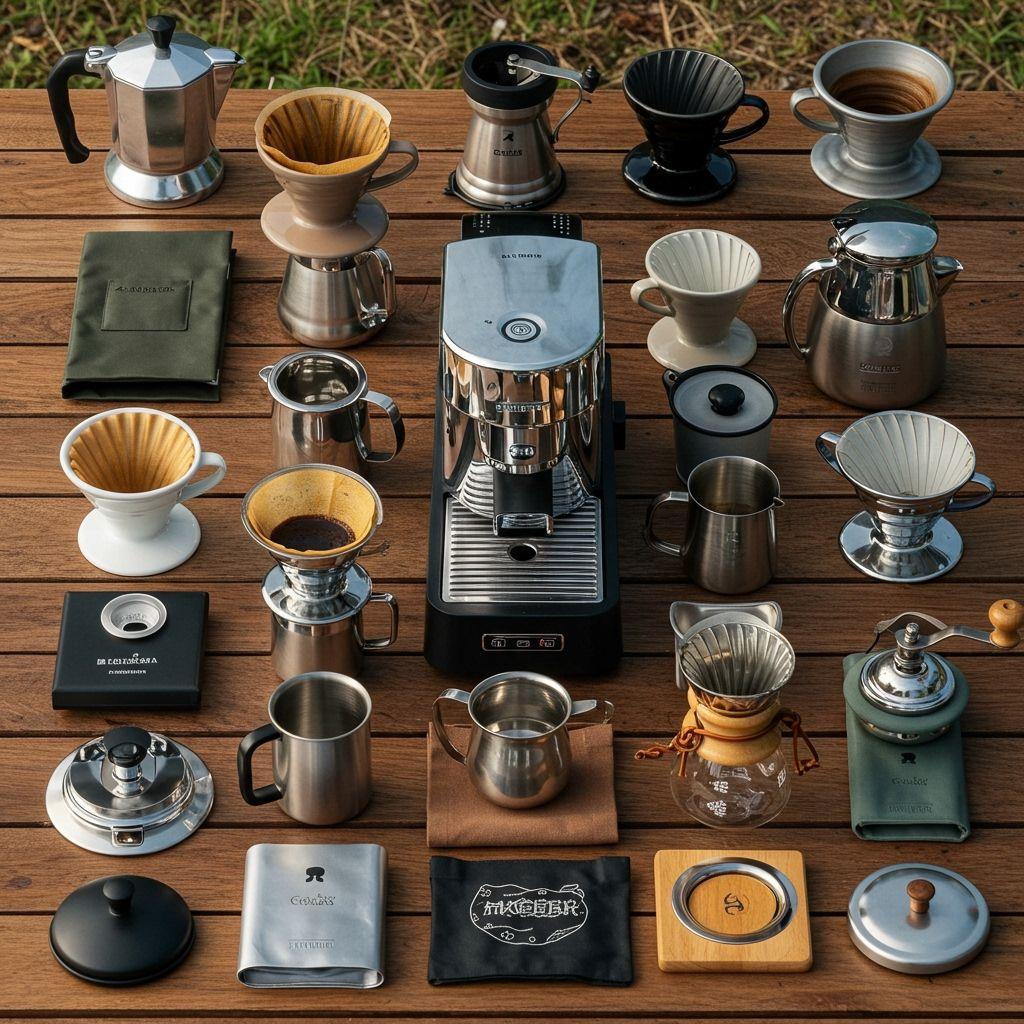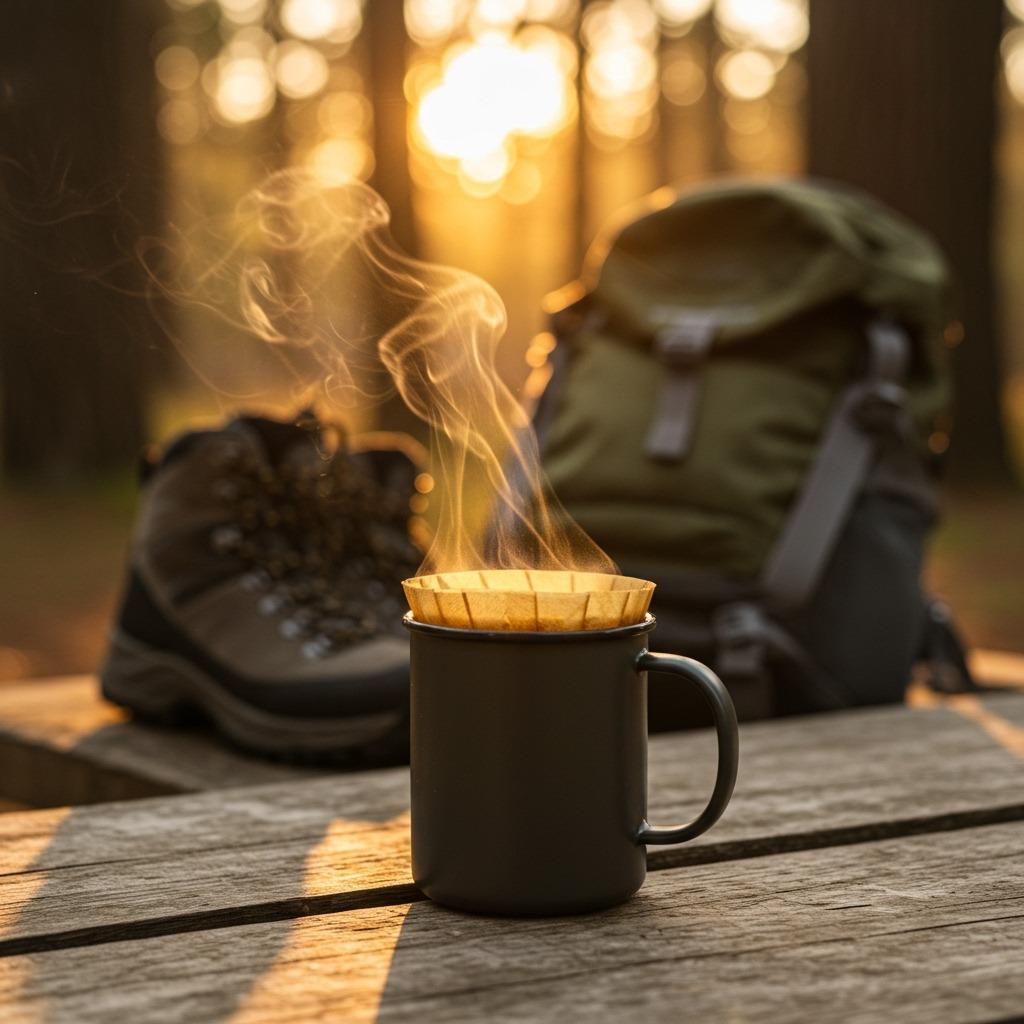Picture this: dawn breaks over your campsite, mist rises from the lake, and you’re fumbling with a finicky camp stove trying to make your morning coffee. Sound familiar? Three summers ago, I discovered that mastering drip coffee—both at home and in the wilderness—transformed my entire outdoor experience. While many adventurers rely on instant coffee or complex espresso setups, drip coffee offers the perfect balance of simplicity, flavor, and reliability that every outdoor enthusiast needs to understand.
Drip coffee is a brewing method where hot water slowly passes through ground coffee beans held in a filter, allowing gravity to extract rich flavors as it drips into a pot or carafe below. This technique creates a clean, balanced cup that’s more complex than instant coffee but far simpler than espresso-based drinks. Whether you’re using an automatic machine at home or a manual pour-over setup at your campsite, understanding drip coffee fundamentals will elevate every morning ritual. For those planning outdoor adventures, our comprehensive camping breakfast ideas guide pairs perfectly with mastering camp coffee techniques.

The Trail Story That Changed My Coffee Game
It was mile 47 of the Colorado Trail when I met Janet, a 60-something section hiker who’d been perfecting outdoor coffee for decades. While I struggled with my temperamental jet boil and instant packets, she calmly set up what looked like a simple metal funnel over her titanium mug.
“Drip coffee,” she explained, measuring grounds with practiced precision. “Same principle as your kitchen machine, just stripped down to essentials.”
She poured hot water in slow, circular motions, and within minutes, the aroma of real coffee filled our alpine camp. That first sip revealed everything I’d been missing—rich, clean flavors with none of the bitter harshness I’d accepted as “camp coffee reality.”
Janet taught me that drip coffee isn’t just about convenience; it’s about understanding extraction fundamentals that work whether you’re at sea level or 12,000 feet. She’d been using the same portable setup for fifteen years, brewing perfect cups from the Pacific Crest Trail to the Appalachian Mountains.
That morning conversation launched my obsession with drip coffee mastery, both in the backcountry and at home.
Understanding the Science Behind Drip Coffee
Drip coffee works through controlled extraction—hot water dissolves soluble compounds from coffee grounds as gravity pulls the liquid through a filter. This process typically takes 4-6 minutes, allowing optimal extraction of oils, acids, and aromatics that create coffee’s complex flavor profile.
Water temperature plays a crucial role. Too hot (above 205°F) and you’ll extract bitter compounds; too cool (below 195°F) and you’ll get sour, under-extracted coffee. This narrow temperature window explains why drip coffee can taste dramatically different even with identical beans and equipment.
Grind size affects extraction speed. Medium grounds—roughly the texture of coarse sea salt—provide ideal surface area for balanced extraction. Finer grinds extract faster but can become bitter, while coarser grinds may taste weak and sour.
Filter type influences final flavor. Paper filters trap oils and fine particles, creating clean, bright coffee. Metal filters allow more oils through, producing fuller-bodied results with slightly more sediment. Neither is “better”—they simply create different taste profiles.
The coffee-to-water ratio determines strength. Most experts recommend 1:15 to 1:18 ratios (1 gram of coffee per 15-18 grams of water), though personal preference and brewing method can adjust this range.
Understanding these variables transforms drip coffee from guesswork into precision brewing, whether you’re using a $200 automatic machine or a $15 camping pour-over.
Automatic vs Manual Drip Coffee: Choosing Your Method
Automatic drip coffee makers handle temperature control, timing, and water distribution automatically. You add grounds to a filter basket, fill the water reservoir, press start, and wait for brewing to complete. Modern machines often include features like programmable timers, temperature adjustment, and pause-and-serve functions.
Benefits of automatic brewing:
- Consistent results with minimal effort
- Perfect for large quantities (6-12 cups)
- Hands-free operation is ideal for busy mornings.
- Built-in warming plates keep coffee hot.
Manual drip coffee (pour-over) gives complete control over every brewing variable. Popular devices include V60, Chemex, Kalita Wave, and simple camping pour-over funnels. You manually control water temperature, pour speed, timing, and technique.
Benefits of manual brewing:
- Complete customization of flavor profile
- Lighter, more portable equipment
- No electricity required—perfect for camping
- Greater connection to the brewing process
- Often produces more nuanced, complex flavors.
Which method suits outdoor adventures? Manual pour-over wins for backpacking and primitive camping due to weight savings and equipment simplicity. Car camping allows either option, though automatic makers require power sources. Many serious outdoor coffee enthusiasts master both methods for different situations.
For those interested in broader outdoor cooking skills, our easy camping dinners guide includes complementary techniques that work alongside coffee brewing routines.

Step-by-Step Drip Coffee Brewing Guide
For Automatic Machines:
- Start with fresh, quality beans ground to medium consistency just before brewing
- Use filtered water heated to 195-205°F (most machines handle this automatically)
- Measure coffee using 2 tablespoons of ground coffee per 6 ounces of water.
- Place a paper filter in the basket, add grounds, and level gently.
- Fill the water reservoir and start the brewing cycle.
- Serve immediately or transfer to a thermal carafe to maintain temperature.
For Manual Pour-Over:
- Heat water to 195-205°F using a thermometer or letting boiled water rest 30 seconds
- Place the filter in the pour-over device and rinse with hot water to remove papery taste.
- Add coffee grounds and create a small well in the center.
- Start with “bloom” – pour just enough water to wet grounds, wait 30 seconds for CO2 release.
- Pour in slow circles starting from the center, working outward, then back to the center.
- Maintain a steady drip rate – total brew time should be 4-6 minutes.
- Remove filter and serve immediately.
Pro Tips for Both Methods:
- Grind beans just before brewing for maximum freshness
- Clean equipment regularly to prevent oil buildup affecting taste.
- Experiment with different coffee origins and roast levels
- Keep detailed notes on ratios and techniques that produce your preferred flavor.
The key to exceptional drip coffee lies in consistency—once you dial in preferred parameters, reproducing great results becomes automatic.
Troubleshooting Common Drip Coffee Problems
Bitter Coffee:
- Water too hot (reduce temperature or let boiled water cool longer)
- Over-extraction from too-fine grounds or too-long brew time
- Dirty equipment with rancid oil buildup
- Poor quality or over-roasted beans
Sour Coffee:
- Water too cool (increase temperature closer to 200°F)
- Under-extraction from too-coarse grounds or too-short brew time
- Insufficient coffee-to-water ratio
- Very light roast beans require longer extraction.
Weak Coffee:
- Not enough coffee grounds (increase ratio to 1:15 or stronger)
- The grounds are too coarse for the brewing method.
- The water is not hot enough for proper extraction.
- Old, stale coffee beans
Inconsistent Results:
- Varying grind sizes (invest in a quality burr grinder)
- Inconsistent water temperature (use a thermometer until you develop intuition)
- Different pouring techniques in manual methods
- Scale buildup in automatic machines is affecting heating.
Outdoor-Specific Issues:
- High altitude requires longer extraction time and possibly finer grounds
- Wind cools the water too quickly during pour-over brewing.
- Hard water from natural sources affects extraction (pack filtered water for coffee)
- Cold weather is making equipment harder to handle (practice techniques at home first)
Most drip coffee problems stem from inconsistent variables rather than equipment failure. Systematic troubleshooting—changing one variable at a time—quickly identifies solutions.
According to Specialty Coffee Association guidelines, proper brewing technique matters more than expensive equipment for achieving excellent results.
Equipment Recommendations for Every Budget
Budget-Friendly Options ($15-50):
- Melitta Pour-Over: Simple plastic dripper with excellent results
- Mr. Coffee Automatic: Reliable basic brewing for large quantities
- GSI Outdoors Java Drip: Collapsible silicone pour-over perfect for camping
- Hario V60 Plastic: Professional-quality manual brewing at an entry-level price
Mid-Range Choices ($50-150):
- Bonavita Connoisseur: Automatic machine meeting SCA brewing standards
- Chemex Classic: Elegant glass pour-over producing exceptionally clean coffee
- OXO 9-Cup: Well-designed automatic with excellent temperature control
- Snow Peak Field Barista: Premium camping coffee kit for serious outdoor enthusiasts
High-End Equipment ($150+):
- Technivorm Moccamaster: Dutch-built automatic praised by coffee professionals
- Hario V60 Copper: Beautiful, heat-retaining manual dripper
- Ratio Eight: Designer automatic combining aesthetics with precision brewing
- Custom titanium camping setups: Ultralight, durable gear for serious backpackers
Essential Accessories:
- Burr grinder (hand-crank models work great for camping)
- Digital scale for precise measurements
- Gooseneck kettle for controlled pouring
- Quality filters specific to your brewing device
- Insulated carafe for keeping coffee hot
Outdoor-Specific Considerations:
Choose equipment based on weight limitations, durability needs, and power availability. Car camping allows heavier, more complex setups, while backpacking demands ultralight, multi-purpose gear.
The best equipment matches your specific needs and budget—expensive gear won’t fix poor technique, but quality tools make consistent results easier to achieve.

Regional Variations and Global Drip Coffee Culture
Drip coffee techniques vary significantly worldwide, each reflecting local preferences and available equipment:
American Drip: Large-batch brewing using automatic machines, typically producing 8-12 cups simultaneously. Often served with cream and sugar, emphasizing convenience over complexity.
Japanese Pour-Over: Meticulous hand-brewing focusing on precision timing, water temperature, and pouring technique. Methods like V60 and Kalita Wave originated here, emphasizing clean, nuanced flavors.
Vietnamese Drip (Phin): An Individual metal filter placed over cups, using very hot water and finely ground coffee. Produces strong, concentrated coffee often mixed with condensed milk.
Scandinavian Coffee: Light-roasted beans are brewed strongly using various manual methods. Often consumed black tea to appreciate subtle flavor notes.
Ethiopian Coffee Ceremony: Traditional communal brewing involving roasting green beans, grinding by hand, and brewing in clay pots. Emphasizes social connection and ritual.
Specialty Coffee Movement: Global trend toward precision brewing, single-origin beans, and artisanal techniques. Found in third-wave coffee shops worldwide.
Outdoor Coffee Culture: A Growing community of adventurers prioritizing quality coffee in wilderness settings. Combines precision brewing techniques with lightweight, durable equipment.
Understanding regional approaches expands brewing knowledge and appreciation for coffee’s cultural significance beyond simple caffeine delivery.
Advanced Techniques for Coffee Enthusiasts
Once basic drip coffee mastery is achieved, several advanced techniques can elevate results:
Bloom Timing: Experiment with 15-45 second bloom periods to optimize CO2 release and flavor extraction. Freshly roasted beans benefit from longer blooms.
Pulse Pouring: Instead of continuous pouring, add water in 2-3 separate pours, allowing complete drainage between additions. This technique can enhance flavor clarity.
Water Quality Optimization: Use water with 150-300 ppm total dissolved solids for optimal extraction. Many coffee professionals use specific mineral blends in distilled water.
Grind Distribution: Consistent particle size dramatically improves extraction. Quality burr grinders produce more uniform results than blade grinders.
Temperature Profiling: Some advanced brewers start with slightly cooler water (190°F) for initial bloom, then increase the temperature for main extraction.
Agitation Techniques: Gentle stirring during bloom or specific phases can improve extraction uniformity, though the technique varies by brewing method.
Time Manipulation: Adjusting total brew time by 30-60 seconds can dramatically change flavor profiles, especially with manual methods.
Multiple Origin Blending: Mixing beans from different regions can create complex flavor profiles impossible with single origins.
Seasonal Adjustments: Humidity, altitude, and bean age affect extraction, requiring slight technique modifications throughout the year.
These advanced techniques require solid foundational knowledge but can transform good drip coffee into exceptional brewing that rivals specialty coffee shops.
For broader outdoor skill development, our comprehensive camping hacks guide includes additional precision techniques that complement advanced coffee brewing.
Health Benefits and Nutritional Information
Drip coffee offers numerous health advantages when consumed in moderation:
Antioxidant Content: Coffee contains high levels of chlorogenic acids and other antioxidants that may reduce inflammation and support cellular health. Drip coffee retains more antioxidants than espresso due to a longer extraction time.
Cognitive Benefits: Moderate caffeine intake (200-300mg daily) can improve focus, memory, and reaction time. Drip coffee provides controlled, consistent caffeine delivery.
Metabolic Effects: Coffee consumption may boost metabolism by 3-11% and improve fat oxidation during exercise, particularly relevant for outdoor enthusiasts.
Disease Prevention: Regular coffee consumption is associated with reduced risk of Type 2 diabetes, Parkinson’s disease, and certain cancers, though individual responses vary.
Liver Protection: Coffee appears to protect against liver damage and may reduce the risk of liver diseases, including cirrhosis.
Physical Performance: Caffeine can improve endurance and reduce perceived exertion during physical activities like hiking or climbing.
Nutritional Profile (8 oz black drip coffee):
- Calories: 2-5
- Caffeine: 80-120mg
- Antioxidants: High levels of chlorogenic acids
- Minerals: Small amounts of potassium, magnesium, and niacin
Considerations:
- Excessive consumption (>400mg caffeine daily) may cause anxiety, insomnia, or digestive issues.
- Pregnant women should limit intake to 200mg daily.
- Individual caffeine sensitivity varies widely.
- Adding cream, sugar, or flavorings significantly alters the nutritional profile.
For outdoor enthusiasts, drip coffee provides clean energy and health benefits without the artificial ingredients found in many energy drinks or supplements.

Sustainability and Environmental Impact
Coffee production and consumption carry significant environmental implications that conscious consumers should consider:
Bean Sourcing: Choose certified organic, Fair Trade, or Direct Trade coffee to support sustainable farming practices and fair wages for growers. Single-origin beans often have more traceable supply chains.
Packaging: Bulk coffee beans create less waste than individual pods or packets. Reusable containers reduce ongoing packaging waste.
Filter Choices: Paper filters are biodegradable but create daily waste. Metal filters eliminate ongoing waste but require energy for manufacturing and cleaning.
Water Usage: Coffee production requires significant water resources—approximately 140 liters per cup from farm to brew. Using precise measurements reduces waste.
Transportation: Locally roasted beans reduce carbon footprint compared to mass-produced coffee shipped long distances.
Equipment Longevity: Quality brewing equipment lasting decades creates less environmental impact than frequently replaced, cheap alternatives.
Outdoor Considerations:
- Pack out all coffee grounds and filters following Leave No Trace principles.
- Used coffee grounds make excellent compost material at home.
- Choose concentrated formats for backpacking to reduce packaging weight.
- Solar or wood-fired heating reduces fossil fuel dependence.
Ground Disposal: Coffee grounds are excellent garden compost, but can harm aquatic ecosystems. Always dispose of grounds properly in wilderness settings.
Supporting sustainable coffee practices ensures future generations can enjoy both quality coffee and healthy outdoor environments. According to Rainforest Alliance research, certified sustainable coffee farming preserves biodiversity and supports community development.
Pairing Drip Coffee with Outdoor Activities
Different outdoor pursuits call for specific coffee approaches and timing:
Backpacking: Lightweight pour-over setups with pre-ground coffee minimize pack weight. Morning coffee provides energy for challenging ascents, while afternoon brewing offers comfort during rest stops.
Car Camping: Larger automatic coffee makers work well with generator power. Leisurely morning brewing becomes part of the camping ritual, especially on multi-day trips.
Climbing: Quick, high-caffeine brewing supports early alpine starts and sustained focus during technical sections. Portable systems must withstand rough handling.
Fishing: Quiet, patient coffee preparation matches fishing’s meditative pace. Thermos-style brewing keeps coffee hot during long waits.
Hiking: Lightweight systems for trail brewing, or pre-brewed coffee in insulated containers for day hikes. Hot coffee provides comfort during weather breaks.
Winter Sports: High-calorie, hot coffee combats cold-weather energy demands. Insulated brewing equipment prevents freezing in extreme conditions.
Photography Expeditions: Patient coffee brewing complements waiting for perfect lighting conditions. Quality coffee enhances long sessions in beautiful locations.
Timing Considerations:
- Morning coffee before strenuous activities maximizes performance benefits.
- Afternoon coffee can interfere with sleep quality at altitude.
- Post-activity coffee aids recovery and provides a psychological reward.
Group Dynamics: Consider brewing methods that serve multiple people efficiently. Shared coffee rituals strengthen outdoor community bonds.
Matching coffee approach to specific outdoor activities enhances both performance and enjoyment while maintaining practical considerations like weight and preparation time.
For those planning extended outdoor adventures, our detailed camping for beginners guide covers essential skills that complement advanced coffee techniques.
Storing and Preserving Coffee Quality
Proper storage significantly affects coffee quality, especially for extended outdoor trips:
Home Storage:
- Store whole beans in airtight containers away from light, heat, and moisture
- Avoid refrigeration unless freezing for long-term storage.
- Buy smaller quantities more frequently rather than bulk purchases.
- Use beans within 2-4 weeks of roasting for optimal flavor.
Outdoor Storage:
- Pack coffee in waterproof, airtight containers to prevent moisture damage.
- Keep containers in cool, shaded areas of backpacks.
- Pre-portion coffee for each brewing session to minimize container opening
- Consider vacuum-sealed individual portions for longer trips.
Grind Timing: Grind beans immediately before brewing when possible. Pre-ground coffee stales quickly, but it may be necessary for weight-conscious backpacking.
Climate Considerations:
- High humidity accelerates staleness—extra protection is needed in tropical environments.
- Extreme cold can make beans brittle—allow gradual warming before grinding.
- Altitude affects extraction—beans may taste different at elevation.
Container Options:
- Airscape containers remove air after each use
- Vacuum-sealed bags minimize oxidation.
- Metal containers protect from light and physical damage.
- Glass jars work well for home storage, but add weight for outdoor use.
Signs of Stale Coffee:
- Lack of aroma when grinding
- Flat, dull taste lacking brightness
- Minimal bloom during brewing
- Oily surface on dark roasts
Freshness Testing: Fresh coffee should produce noticeable bloom when hot water first contacts the grounds. Minimal or no bloom indicates stale coffee.
Proper storage preserves the investment in quality beans and ensures consistent brewing results throughout extended outdoor adventures.
Future Trends in Drip Coffee Technology
Coffee brewing technology continues evolving, with several trends particularly relevant for outdoor enthusiasts:
Smart Brewing Devices: WiFi-connected machines allowing remote operation and precision control via smartphone apps. Some models can start brewing automatically based on location data.
Portable Precision: Lightweight digital scales, thermometers, and timers designed specifically for outdoor use. Some integrate multiple functions into a single device.
Solar-Powered Equipment: Solar coffee makers and heating elements reduce dependence on fossil fuels for remote brewing.
Advanced Materials: Titanium and carbon fiber brewing equipment offering superior strength-to-weight ratios for serious backpackers.
Subscription Services: Direct-to-consumer coffee delivery services offering beans optimized for specific brewing methods and delivered on custom schedules.
Sustainable Innovations: Biodegradable filters, reusable pod systems, and packaging made from agricultural waste, reducing environmental impact.
Flavor Enhancement: Controlled oxidation techniques and precision roasting create more complex flavor profiles from single-origin beans.
Integration Technology: Brewing equipment that interfaces with fitness trackers and nutrition apps to optimize caffeine timing for performance.
Miniaturization: Increasingly compact brewing systems maintain quality while reducing pack weight for ultralight backpacking.
These innovations promise to make quality drip coffee more accessible and precise for outdoor enthusiasts while supporting sustainability goals and performance optimization.
The future of outdoor coffee culture will likely combine traditional brewing wisdom with cutting-edge technology, creating opportunities for both convenience and artisanal quality in wilderness settings. As National Coffee Association research shows, coffee quality expectations continue rising across all demographics, driving continued innovation in brewing technology.
Frequently Asked Questions
What exactly is drip coffee, and how is it different from other brewing methods?
Drip coffee is made by pouring hot water over ground coffee beans held in a filter, allowing gravity to extract flavors as the water drips through into a pot below. Unlike espresso (which uses pressure) or French press (which uses immersion), drip coffee relies on controlled water flow and filtration, creating cleaner, brighter flavors with less oils and sediment.
How do I choose between automatic and manual drip coffee makers?
Choose automatic machines if you want consistency, convenience, and the ability to brew large quantities with minimal effort. Manual pour-over methods offer complete control over brewing variables, work without electricity, pack lighter for camping, and often produce more nuanced flavors—but require more skill and attention.
What’s the ideal coffee-to-water ratio for drip coffee?
The standard ratio is 1:15 to 1:18 (1 gram coffee per 15-18 grams water), which translates to roughly 2 tablespoons ground coffee per 6 ounces water. Start with 1:16 and adjust stronger or weaker based on taste preferences. Stronger ratios work well for lighter roasts, while darker roasts may prefer weaker ratios.
Why does my drip coffee taste bitter or sour?
Bitter coffee usually indicates over-extraction from water that’s too hot (above 205°F), grounds that are too fine, or brewing too long. Sour coffee suggests under-extraction from water that’s too cool (below 195°F), grounds that are too coarse, or insufficient brewing time. Adjust one variable at a time to dial in proper extraction.
Can I make good drip coffee while camping without electricity?
Absolutely! Manual pour-over methods work perfectly for camping—you just need a way to heat water, ground coffee, filters, and a simple dripper. Many lightweight camping-specific pour-over devices are available, or you can use improvised methods like coffee socks or bandana filters in emergency situations.
How long does brewed drip coffee stay fresh and flavorful?
Brewed drip coffee tastes best within 30 minutes of brewing. After that, oxidation and continued heating cause flavor degradation. If you must store brewed coffee, use an insulated thermal carafe rather than a heating plate, and consume within 2-4 hours for acceptable quality.
Drip coffee represents the perfect intersection of simplicity and sophistication—accessible enough for camping beginners yet complex enough to satisfy serious coffee enthusiasts. Whether you’re brewing your first cup at a trailhead or perfecting advanced techniques for backcountry gourmet experiences, mastering drip coffee fundamentals enhances every outdoor adventure. The combination of reliable caffeine delivery, customizable flavors, and equipment versatility makes drip coffee an essential skill for anyone who takes their outdoor coffee seriously. From automatic machines at base camp to ultralight pour-over setups on remote peaks, drip coffee adapts to any adventure while maintaining the quality and ritual that transforms morning fuel into genuine pleasure.
